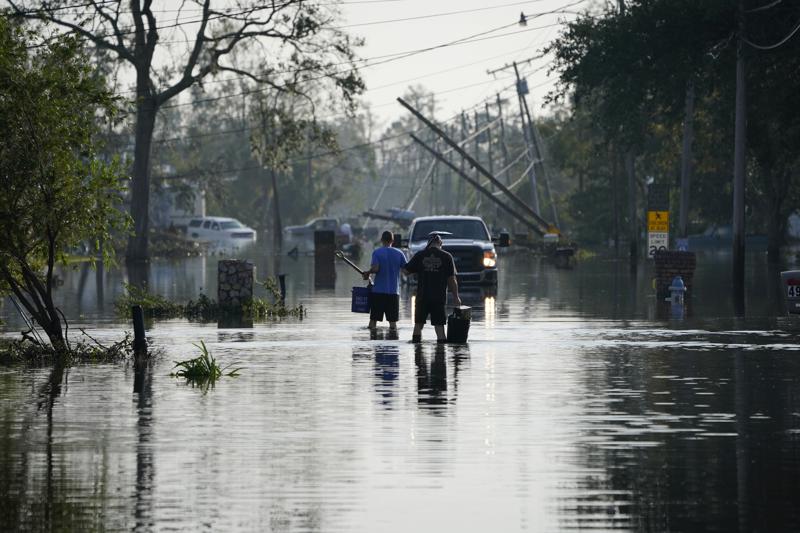
NEW ORLEANS (AP) — Lights came back on for a fortunate few, some corner stores opened their doors and crews cleared fallen trees and debris from a growing number of roadways Wednesday — small signs of progress amid the monumental task of repairing the damage inflicted by Hurricane Ida.
Still, suffering remained widespread three days after Ida battered Louisiana and parts of Mississippi as the fifth-most-powerful hurricane to strike the U.S. Some low-lying communities remained largely underwater. Roughly a million homes and businesses still had no electricity, and health officials said more than 600,000 people lacked running water.
Louisiana Gov. John Bel Edwards said he was pleased that power had returned for some people, saying it was “critically important to show progress” after the storm. But he also acknowledged that much more work lay ahead.
“I’m very mindful that it’s a start, and only a start,” he told a news conference.
Edwards said Louisiana was blessed to have only two deaths from Ida so far given the magnitude of the hurricane’s devastation.
In southern Louisiana’s Plaquemines Parish, Gayle Lawrence lost two cars, refrigerators and almost everything in her garage to flood waters. Her garage was filled with marsh grass and dead fish. Scores of other homes in the neighborhood were also flooded.
“The house is solid. It didn’t even move. But when the water came up, it destroyed everything,” she said.
In Jefferson Parish, hospital staff, food bank employees and other critical workers were hampered by a gas shortage, said parish president Cynthia Lee Sheng. The parish neighbors New Orleans and saw widespread destruction from Ida. Authorities were still waiting for floodwaters to recede enough for trucks carrying food, water and repair supplies to begin moving into Lafitte and other low-lying communities.
“Today we’re a broken community. It won’t always be that way,” Sheng said after meeting with Edwards.
With all of New Orleans blacked out except for those running generators, Byron Lambert woke up startled at about 1:30 a.m. when light suddenly came on down the hall from where he slept. He first thought it was a burglar, then realized his home had electricity.
Lambert’s house in eastern New Orleans was among more than 11,000 homes and businesses that had power restored early Wednesday, according to the electric company Entergy.
“When it came on it startled me. I’m like ‘All right! We got power,’” Lambert said, his enthusiasm tempered by the knowledge of what others were going through. “I’m fortunate, but they have a lot of people that aren’t as fortunate as me, and I pray for them because it’s rough.”
In neighboring Mississippi, 32,000 customers had no electricity.
Hard-hit areas in southeast Louisiana were under a heat advisory Wednesday, with forecasters warning combined heat and humidity could make some areas feel like 108 degrees Fahrenheit (42 degrees Celsius). Officials scrambled to offer food, water and places to cool off.
National Guard troops had handed out more than 141,000 meals, 143,000 liters of water and more than 500 tarps in Louisiana as of Wednesday morning, according to Edwards’ office. In New Orleans, officials opened seven places where people could get a meal and sit in air conditioning. The city was also using 70 transit buses as cooling sites, Mayor LaToya Cantrell said.
Meanwhile, more than 1,200 people were walking through some of Ida’s hardest-hit communities to look for those needing help, according to the Louisiana Fire Marshal’s office.
Search and rescue missions were tapering off, but continued in four parishes that still had floodwaters, Brig. Gen. Lee W. Hopkins of the Louisiana National Guard said on a Zoom call. That’s compared to 31 parishes in the hours immediately after the storm.
President Joe Biden was to visit Louisiana Friday to survey the damage, the White House said.
In New Orleans, where the mayor estimated roughly half the population had evacuated, there were additional signs of recovery. Flags hung from dangling power lines to help drivers avoid them, and in one neighborhood, someone decorated the downed lines with strands of tinsel in an echo of Mardi Gras.
City crews removing debris from roads and cutting up fallen trees had some streets almost completely cleared, while others remained cluttered with obstacles.
A few corner stores were open, many taking cash only, though some had working ATM machines. In many areas, National Guard troops or law enforcement stood posted at pharmacies and gas stations, where drivers waited in long lines for fuel.
Louisiana’s transportation department announced that all interstate systems across the state had reopened and been cleared of debris. AT&T, which faced widespread cellphone outages after Ida, said it was currently operating at more than 90% of normal capacity.
As a clearer picture of Ida’s devastation emerged, the hurricane likely caused $50 billion to $60 billion in total damage, estimated Karen Clark, who has calculated catastrophic risk since 1987. Her risk modeling company, Karen Clark and Company, figured just $18 billion of those losses would be insured.
Those estimates would rank Ida anywhere from the fifth- to seventh-costliest U.S. hurricane based on data from the National Oceanic and Atmospheric Administration. Katrina, Harvey, Maria and Sandy were well over that amount. NOAA says 2017’s Irma incurred about $55 billion in damage and 1992’s Andrew about $53 billion in 2019 dollars.